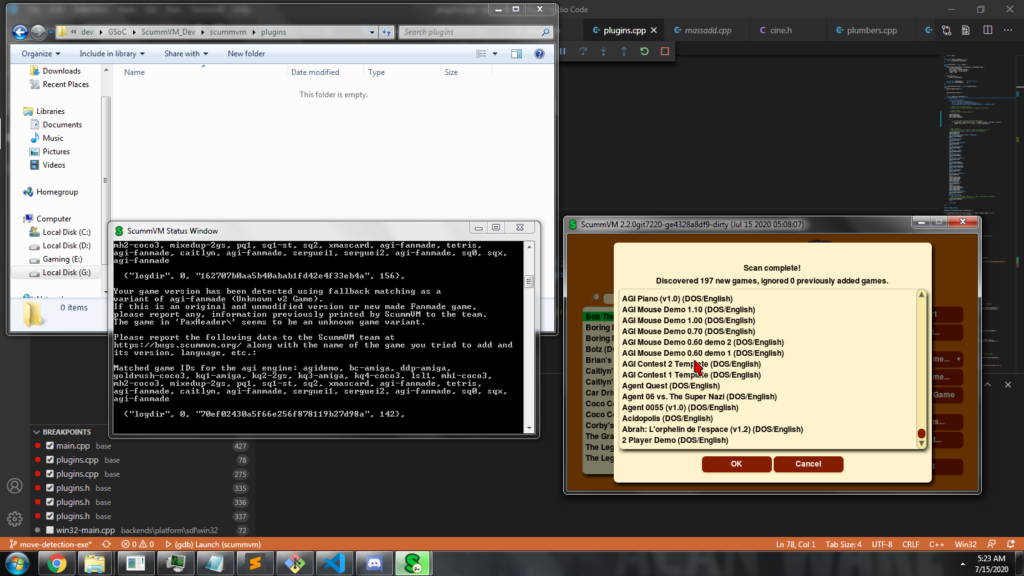Hello! The first few days this week, I spent trying to understand my task, and work on a small number of engines, and try to make games detect/work as a means to see if everything would work as expected. But first, some context.
ScummVM has a MetaEngine and a Engine.
MetaEngine
Engine
So, what is the task exactly?
- For makefiles, introduce a variable for Detection Objects and add it as a dependency for the scummvm executable. This way, before scummvm.exe is built, these are compiled and linked with scummvm.exe
- For engines, isolate MetaEngine code and temporarily comment a bridge function
- createInstance. Creating an instance means we actually try to instantiate an engine. This is a method of MetaEngine and connects an Engine with MetaEngine.
That’s it! I did the above for 3 engines – AGI, CINE, PLUMBERS. I had no need for the latter two though, but I wanted more than one engine as part of the preview? or whatever I was doing.
A while back, Eugene had given me a link, which had a huge number (197 or so!) of AGI (fanmade) Games. I thought it would be a good point to see if the above steps worked correctly or not. It worked well, and the result from before/after the work was the same. Fallback detection worked too!
Perhaps it was not a big deal, but I finally had something to share! I’m taking a lot of time to think and understand this task, and many days had passed by without me sharing any update. I could finally share a small update and make a few commits for my mentors or community to check out, so that was good. It feels a little weird that I’d check-in and out without showing code progress for so many days, so for me to actually show something was good.
I also took a small test, I uncommented code in createInstance where engines were being instantiated and added plugins as a dependency for the executable.
That means all engine.dll’s depend directly on the executable i.e implicit linking. This type of linking would mean a .dll file to be present for the executable to run. If it does not exist, the application would crash.
That’s not really how it should work – engine.dll’s are explicitly linked i.e they’re not dependent on executable. It’s loaded on-demand and if not present, the application would not crash.
However, I just did the test to see if engines could instantiate and run properly – and they did, indeed!
Eugene recently reviewed my newly made commits and left a lot of comments. I made some mistakes, or rather – didn’t correctly understand why some things were the way they were. A small discussion in the group took place, and I think I know the way to move forward now and incorporate the changes in a better way.
Overall, I think I have the basic idea of the end goal, as well as a temporary piece of code that achieves this (with a few incorrect assumptions). Now, I need to implement everything in a correct manner and maintain the engine changes in a clean and maintainable manner.
Though I think there are still some key things I don’t fully understand, but the discussion recently should be enough to guide me in the right direction.
Lastly, my finals were scheduled to start tomorrow, but it was postponed again. I am glad about it, because I can work till the end of summer without taking a break of 1-2 weeks. Phew!
That’s it for this week! My previous PR has some more comments now, which I will have a look now, review it myself and make the necessary changes.
This next week, I want to accomplish the changes (for the new task) in a way that my mentors expect and have a few more commits and enable a few engines regarding that. Once I have the “go” for that / everything seems ok, I can start going engine by engine to incorporate the changes on a bigger scale.
Thanks for reading!
